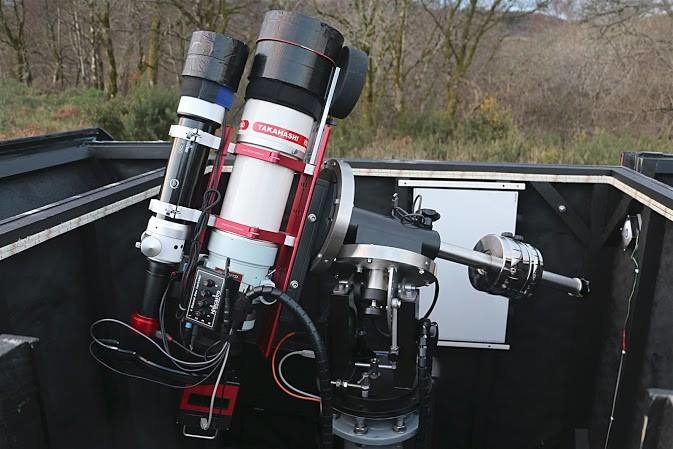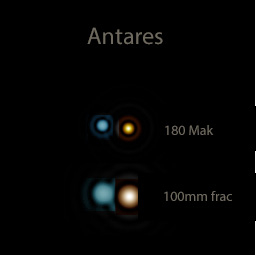-
Posts
53,756 -
Joined
-
Last visited
-
Days Won
455
Content Type
Profiles
Forums
Gallery
Events
Blogs
Posts posted by John
-
-
-
When I've been doing outreach sessions with my 12 inch dobsonian I've noticed that younger eyes seem generally more sensative to seeing colour in astro targets than mine are. Some older observers struggle to see even the colour different in the binary Albireo for example wheras the youngsters shout out the colour difference between the stars often without prompting.
-
 2
2
-
-
Hope your shoulder gets better over time - they are painful !.
A lower back injury a few years back made me think carefully about kit choices too. It's recovered now but I certainly would not want to aggravate it again.
-
 1
1
-
-
Changing to a new Evolution 8 will cost the OP around £1,500 for 2 inches less performance (assuming £400 raised from the sale of the 10 inch dob). Not sure thats the way to go for the OP myself but more info on where they themselves would like to go would help

-
 2
2
-
-
An SCT will require cool down time if it's bought from inside. Also a dew shield and / or a heated dew band is more or less mandatory because the corrector lens acts as a dew magnet.
All we have from the original post is " I'm finding it a bit difficult to transport and tedious to set up each time ".
I think some more information would be helpful but I tend to think of dobsonians as the easiest and quickest medium aperture (ie: 8-12 inch) telescopes to set up and use. I have owned a Celestron 8SE and it's a good scope but the power needs to be connected, the scope cooled for longer than a newtonian and the GOTO setup using the alignment process.
A dob can be up and running in a couple of minutes for low to medium power observing. Plus my £200 8 inch F/6 dob tended to show things as well if not a little better than the 8 inch F/10 SCT did.
Some more specific feedback from the original poster would help though.
-
 1
1
-
-
8 minutes ago, NGC 1502 said:
A more expensive option is a Dob from Orion Optics UK.
Their 10” Dob is noticeably lighter than a Skywatcher equivalent.
I own an 8” and a 10” Dob from OO UK, the difference in the views is not that much. An 8” OO is considerably lighter than a 10” SW. About 12 years ago I owned a 10” SW Dob, I had to carry it down a flight of stairs to use it, so I’m aware of the problem.
Ed.
Very true - my 12 inch OO UK dob is around the same weight as the Skywatcher 10 inch.
-
With your 30mm eyepiece you might be seeing M57 but be mistaking it for a slightly bloated star - it's not very big at all. M27 is also a planetary nebula but much larger and obvious even at low power.
Thats one of the challenges with DSO's, getting an idea of what to actually look for. Their sizes are all over the place and the photos don't help assess how they will actually look with your scope and eyepieces.
I've found that the key things are:
- Good finder options, aligned accurately with the scope optics and that you have confidence in using. I use a Rigel Quickfinder and a 9x50 RACI optical finder.
- A low power / wide angle eyepiece as a 3rd line of finder.
- A good star chart that presents roughly the amount of stars that your optical finder will show - I use the Sky & Telescope Pocket Sky Atlas
- Pick some easy finds to get going then move onto more challenging stuff.
- End the session on an easy object so you end on a positive note.
-
 4
4
-
-
Perhaps what we need is for the manufacturers to re-vamp their 82 degree ranges so that they achieve the positive characteristics of the 100's that are now around with a more modest AFoV for those who prefer that. There are continued rumours across the pond of a Tele Vue "Nagler 2" design sporting an 85 degree AFoV and better eye relief across the range but nothing concrete as yet.
Vixen nearly achieved something great with their SSW range but IMHO some small but annoying issues have held them back.
A topic for a different thread though !

-
Good stuff Piero - glad to hear a positive report

I'm surprised that you see much coma at F/6 though. It's hardly noticable at all with my F/5.3 even with the Ethos eyepieces - at most just a touch right where the FoV meets the field stop.
I cool my 12 inch at a 45 degree angle but it's useable pretty much straight away at low to medium powers.
-
That looks a sophisticated collimation device - mine is a cheapo plastic cheshire

-
 1
1
-
-
Glad you got a 20 in the end Mark

I'm sure the views of M13 etc will be wonderful - it's pretty cool in my 12 !
-
-
I have used my 2-4mm Nagler zoom quite often with my 12 inch dob, which I didn't really anticipate when I bought the zoom - I thought it would be in the refractor focusers mainly. I can't say that I've used the 2.5mm and 2mm settings that often though with the 12 - apart from the seeing, my floaters tend to hog the field of view with that exit pupil !
-
 1
1
-
-
22 hours ago, Piero said:
You might find that you want to be able go higher than 270x with a good mirror like that in the scope. Over the past few years that I've had my 12 inch F/5.3 I've found myself using 300x - 400x more often than I ever thought I would. This sort of magnification helps to tease out faint point sources such as planetary moons around Uranus and Neptune, central stars of planetary nebulae etc, etc.
I've also found 320x (Pentax 5mm XW) really useful for picking out the finest lunar details such as Plato cratelets beyond the "big 4" and the central rille in the Vallis Alpes.
Obviously the seeing needs to co-operate as well but its useful to be able to "go to 11" sometimes

-
 4
4
-
-
Lovely scope Piero - congratulations

-
 1
1
-
-
It would be good to see FLO & IK at the IAS

-
 1
1
-
 1
1
-
-
I've met and spoken with Ian a couple of times - he is a very helpful and knowledgeable chap. I bought my Tak FC-100DL from IKI and was very pleased with their service

I'm sure the IK - FLO partnership will be very successful.
-
 1
1
-
-
Hi Craig,
Sorry I missed your post.
I don't recall having used a Vixen LV in cold weather so I can't really comment specifically.
Generally speaking with all the eyepieces that I've owned and used, with the exception of some designs fogging occasionally if they get cold, I've not noticed any cold conditions issues with them.
-
Congratulations on your pending retirement Dave

You won't regret it despite the downsizing of the scope fleet.
They do look lovely though !
-
 1
1
-
-
On 12/06/2019 at 11:18, Skipper Billy said:
Your scopes are already well cluttered with cables and whatnot plus the Tak already has some red on it. The scope I was referring to should look like the pic below IMHO but the owner that my comment above was directed at (no longer an SGL member) decided to build a cage for it from 4 Primaluce tubr rings and a couple of their Losmandy DT bars, just in case it tried to escape

Still, each to their own.
-
 3
3
-
-
"....with atmospheric refraction and seeing wobbles, colour is always a bit subjective!...."
It most certainly is !
That image is close to what I observed in terms of scale and hues during the moments of best steadiness, which were rather few of course. The kaleidoscopic effect of the atmosphere on the primary star was doing it's best to keep the secondary a secret

-
 1
1
-
-
1 hour ago, chiltonstar said:
I've done it in the past with an 80ED - I don't think aperture is the main issue really, it's more about seeing and as John says, having a clear S aspect (and of course having any clear nights).
This is a simulation (Aberrator) of Antares with a 180 mm Mak and a 100mm frac - you can see both can split it easily; I've added a bit of colour for fun!
Chris
Thanks for that Chris. If those position angles are right then that builds my confidence more that I got the split. I'd say that last night the secondary looked a smaller blob than the primary and rather more the colour of dirty blu tack !
It was good to be observing something last night, I've not been out much due to the poor weather lately.
-
 2
2
-
-
I'm sure it is possible with the 100DC David. The secondary star does come and go quite frequently as the seeing fluctuates and is pretty close in to the primary as well as being indistinct.
To be honest I could not recall the position angle of the secondary before I observed tonight but I suspected that I was seeing something a touch N of due W of the primary when Antares popped into view from behind my neighbours roof. My "suspect" was just in front of the primary and a touch to the north as it drifted across my undriven field of view. I kept at it to catch the steadier moments and gradually became more convinced that I was really seeing the secondary star popping in and out of view.
I'd like to try this again from our society observatory site which has a much clearer southern horizon than I have at home.
-
 2
2
-
-
Well now - got some clear skies at last and also managed to split Antares during it's pass between the house rooftops and some large chestnut trees. The secondary was intermittently visible almost due west of the primary as Chris / chiltonstar says above. I made a rough sketch to confirm the position of the secondary when it was popping into view. The pleasing thing about this split was that I was using my Takahashi FC-100DL at 225x (Nagler zoom at 4mm setting). Considering the low elevation of Antares this was a pretty credible performance from the 10cm Tak I think. The primary star was showing the effects of being viewed through a goodly chunk of the atmosphere but quite often the glare was well controlled enough to allow the fainter greenish-grey secondary star to show itself.
-
 6
6
-












What DSO’s to view in July 2019
in Getting Started With Observing
Posted
The planetary nebulae M57 and M27 (the Ring and the Dumbell nebulae) are well placed at around midnight, vary in appearance (one small and one extended) and both reasonably bright. Good targets for a 10 inch scope at the moment and have plenty of star patterns around them for star hopping.
Congratulations on M13 - when the sky is dark and the eye adapted, it can start to look like it's photos at around 100x with a 10 inch scope - wonderful target !